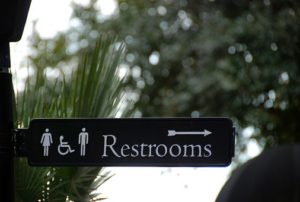 Have you ever experienced a sudden, eye-watering strong, unable-to-defer, need to go to the toilet? If so then you have experienced what is called urinary urgency. This is the main symptom of a condition called Overactive Bladder Syndrome (OAB).
Have you ever experienced a sudden, eye-watering strong, unable-to-defer, need to go to the toilet? If so then you have experienced what is called urinary urgency. This is the main symptom of a condition called Overactive Bladder Syndrome (OAB).
OAB can be a huge interruption to one’s life. Research has found that the OAB symptoms of urgency and frequency have a much worse impact on womens’ quality of life than the actual leaking of urine.
Our previous blog (Get That Control Back) explains a bit about how the bladder works to fill and empty. In normal bladder control the detrusor (the bladder muscle) stays relaxed to allow it to gradually fill with urine from the kidneys. At the same time the pelvic floor muscles gently work to help keep the bladder exit closed. When a certain amount is in the bladder you will feel the first awareness that your bladder is getting full. When you decide it is convenient to go to the toilet, the pelvic floor muscles relax and the detrusor contracts to push the urine out. This is all controlled by nerve messages between the brain, the bladder and the pelvic floor muscles.
Most people won’t feel an urgent desire to pass urine until their bladder is holding more than 400mls and this desire will build gradually. In OAB people experience an urgent desire with little warning, to pass urine at small bladder volumes (eg 100-200mls) and they usually feel they cannot hold on for even 5 minutes.
The symptoms of urgency in OAB are usually due to an ‘unstable’ detrusor muscle. During the phase when the bladder should remain relaxed to allow it to fill, the detrusor muscle spontaneously and involuntarily contracts and squeezes. This is when the sudden, strong urge to pass urine is felt. Sometimes the detrusor contractions can be set off by triggers. Common triggers include running water and putting your key into the door. It can also be related to fluid intake and low bladder capacity.
You may suffer from urgency but not actually leak any urine and this is called OAB dry. Or you may suffer from some leakage as well as urgency and this is called OAB wet. Often leakage occurs during the desperate rush to get to the bathroom when the urgency is felt. The stress from panicking and the pressure from moving too quickly to get to the toilet is what actually causes the pelvic floor to let go and leak. Instead of rushing, you should stay calm and use the pelvic floor activation. The desperate urge will pass in a few minutes and you can then take your time to get to the toilet.
Treatment for OAB can be extremely helpful and includes pelvic floor muscle strengthening and co-ordination exercises, lifestyle changes, and bladder and behaviour retraining.
Bonnie, at Bend + Mend Sydney CBD has specialised training in helping women with this, and similar, Women’s health issues. Book in to see us today!





